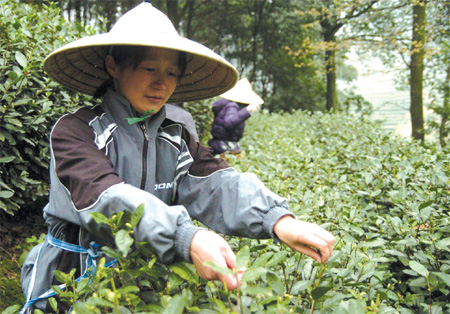Economy
Tea Time
Updated: 2011-01-21 12:49
(China Daily European Weekly)
|
 A farmer collects tea in West Lake district, Hangzhou, Zhejiang province, in March 2010. Shi jianxue / for China Daily |
Chinese green tea is still waiting to be fully appreciated in overseas markets
Louise Hebbourn, 49, a housewife in London, always has tea as her first drink and then frequently for the rest of the day. She sometimes drinks Chinese tea, but she does not like powdered green tea, which she finds "too bitter". Hebbourn can well be justified for her comment, because the Chinese green tea she gets from a supermarket in London is most probably not of the best quality. The very best stays within Chinese domestic market.
Chen Hao, a researcher with the Zhejiang Entry-Exit Inspection and Quarantine Bureau, says China exports goods of top quality to other countries, "but green tea is an exception".
Chen says the supply of best quality green tea such as Longjing can barely meet its domestic demand, while the threshold for tea imports set by the European Tea Committee (ETC) is often considered too high for Chinese tea producers.
Tea plants flourish at the temperature of 30 C and are largely grown in 20 provinces and autonomous regions throughout China. The country is one of the biggest tea producers in the world and its tea products, categorized into six varieties including green tea, black tea and white tea, account for one-quarter of the world's total.
In 2009, China's tea output hit 1.24 million tons, according to the China Tea Marketing Association (CTMA).
The export of tea from China has a long and turbulent history. CTMA studies show China virtually monopolized the world tea market supplying 86 percent of global consumption as late as 1871.
Tea was China's prime export to major markets in Europe and North America, but today the figure stands at about 1 percent of the country's exports. The world's major players now include Kenya, Vietnam, Japan, Indonesia, India and Sri Lanka.
Customs reports show that in 2009, China exported a total of 303,000 tons of tea, valued at $705 million (528 million euros), to 120 countries and regions, with eight countries accounting for 60 percent of the total.
Morocco ranks top with 58,500 tons, the Republic of Uzbekistan second with 22,000 tons and Russia third with 21,000 tons. The UK market is so small it is not even specified in the report.
But green tea occupied 75.7 percent of China's total tea exports in 2009, valued at $525 million with a total volume of 229,300 tons.
On the other hand, China imported 921 tons of green tea from such countries as Japan, Sri Lanka and Vietnam.
Green tea forms about 10 percent of the global tea trade, with black tea being the most-consumed category.
E-paper

Ear We Go
China and the world set to embrace the merciful, peaceful year of rabbit
Preview of the coming issue
Carrefour finds the going tough in China
Maid to Order
Specials

Mysteries written in blood
Historical records and Caucasian features of locals suggest link with Roman Empire.

Winning Charm
Coastal Yantai banks on little things that matter to grow

New rules to hit property market
The State Council launched a new round of measures to rein in property prices.
